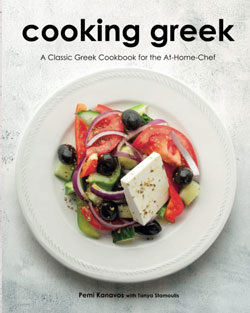I love shrimp saganaki! I never thought to make it, but I bumped into this recipe and thought I would share:
Ingredients:
- 1 pound of shrimp, deveined and peeled
- 1 can of diced tomatoes
- 1 cup of crumbled feta cheese
- 2 tbsp of olive oil
- 1 chopped onion
- 2 minced garlic cloves
- 1 tsp of dried oregano
- Salt and black pepper to taste
- Fresh parsley, chopped
Instructions:
1. Preheat your oven to 375 degrees F.
2. In a large skillet, heat olive oil over medium heat. Sauté the chopped onions and minced garlic until they are softened.
3. Add the canned diced tomatoes to the skillet and stir in the dried oregano. Continue to cook for another 5 minutes until the tomatoes have softened and thickened.
4. Add the shrimp to the skillet and season with salt and black pepper to taste. Cook the shrimp until they become pink and tender (approximately 3-4 minutes).
5. Transfer the shrimp and tomato mixture to a large oven-safe baking dish.
6. Evenly sprinkle the crumbled feta cheese on top of the shrimp mixture.
7. Place the baking dish in the oven and bake for 10-12 minutes or until the cheese has melted and the dish is heated through.
8. Take the dish out of the oven and sprinkle chopped parsley on top before serving.
9. Enjoy your delicious shrimp saganaki with crusty bread or rice.

Ingredients:
- 1 pound of shrimp, deveined and peeled
- 1 can of diced tomatoes
- 1 cup of crumbled feta cheese
- 2 tbsp of olive oil
- 1 chopped onion
- 2 minced garlic cloves
- 1 tsp of dried oregano
- Salt and black pepper to taste
- Fresh parsley, chopped
Instructions:
1. Preheat your oven to 375 degrees F.
2. In a large skillet, heat olive oil over medium heat. Sauté the chopped onions and minced garlic until they are softened.
3. Add the canned diced tomatoes to the skillet and stir in the dried oregano. Continue to cook for another 5 minutes until the tomatoes have softened and thickened.
4. Add the shrimp to the skillet and season with salt and black pepper to taste. Cook the shrimp until they become pink and tender (approximately 3-4 minutes).
5. Transfer the shrimp and tomato mixture to a large oven-safe baking dish.
6. Evenly sprinkle the crumbled feta cheese on top of the shrimp mixture.
7. Place the baking dish in the oven and bake for 10-12 minutes or until the cheese has melted and the dish is heated through.
8. Take the dish out of the oven and sprinkle chopped parsley on top before serving.
9. Enjoy your delicious shrimp saganaki with crusty bread or rice.



